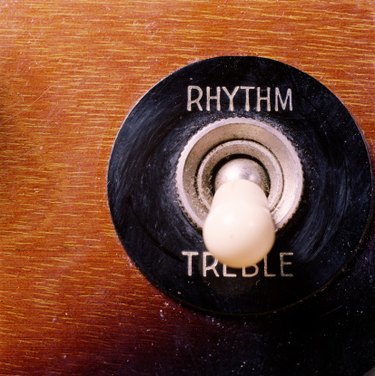
A six-pin toggle switch is also called a double-pole double-throw, or DPDT, switch. The term double-throw means that you can connect two separate devices, and each switch position selects one of the two devices. The term double-pole generally means that two pins/terminals exist for each connection point. The DPDT switch has two basic forms: On-On and On-Off-On. An On-On DPDT switch only has two positions. An On-Off-On DPDT switch is similar to On-On, but it has a center position that is isolated from the other two positions. Testing an On-On, DPDT toggle switch with a multimeter is one way to understand how you can wire the six terminals.
Step 1
Connect one alligator clip to each wire of the 9-volt battery clip. If the toggle switch has screw terminals, skip this step. If necessary, use wire strippers to expose enough bare wire on the two wires of the battery clip. Wrap the bare wire around the alligator-clip screw clockwise, and use a screwdriver to tighten each screw.
Video of the Day
Step 2
Plug the red multimeter probe into the "Volts" port on the multimeter. Plug the black multimeter probe into the "Com" or "Ground" port. Set the multimeter to measure voltage, and place the level on 20V. Refer to your multimeter manual for more information.
Step 3
Connect the red multimeter probe to a terminal on one end of the toggle switch. Use the probe clip to attach it. Move the lever, or toggle, part of the switch so it is at that end terminal. This will be the "A" position of the toggle switch.
Step 4
Connect the black multimeter probe to the other terminal in the A position of the toggle switch. Use the probe clip to attach it.
Step 5
Connect the positive/red wire of the battery clip to the middle terminal of the toggle switch, near the red multimeter probe. Use the alligator clip for the connection. If the toggle switch has screw terminals, connect the red wire of the battery clip by wrapping the bare wire around the screw clockwise. Use wire strippers to expose enough bare wire, and use a screwdriver to tighten the screw.
Step 6
Connect the negative/black wire of the battery clip to the middle terminal of the toggle switch, near the black multimeter probe. If the toggle switch has screw terminals, wrap the black wire around the screw and tighten with a screwdriver.
Step 7
Attach the 9-volt battery to the clip, and turn on the multimeter. Keep the toggle in the A position.
Step 8
Observe the multimeter display. It should read around 9V. Move the toggle to the other end of the switch. This will be the "B" position. Observe the multimeter display. It should read 0V.
Step 9
Move the red multimeter lead to the terminal in the B position of the toggle switch. Connect it to the terminal near the red battery wire. Move the black multimeter lead to the terminal in the B position, near the black battery wire.
Step 10
Keep the toggle in the B position, and observe the multimeter display. It should read around 9V. Move the toggle back to the A position. The multimeter should now read 0V.
Video of the Day